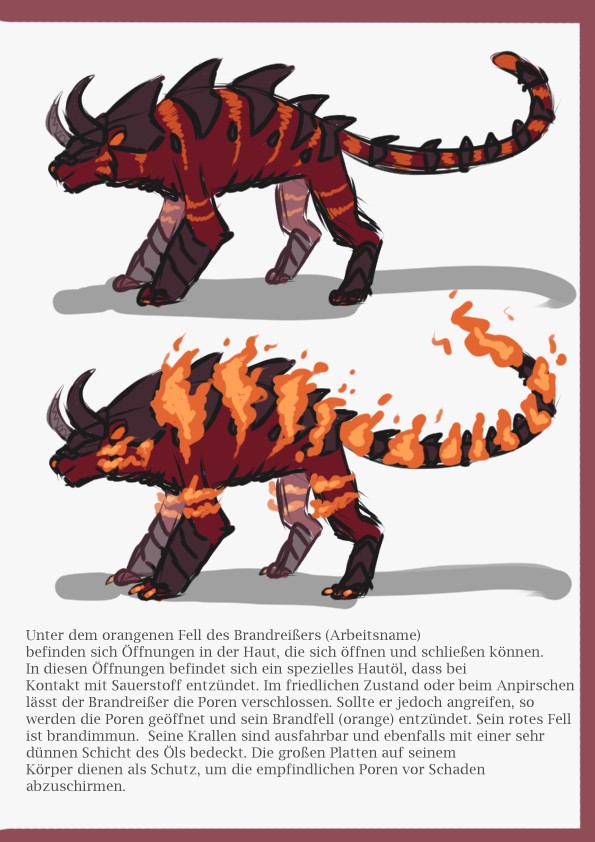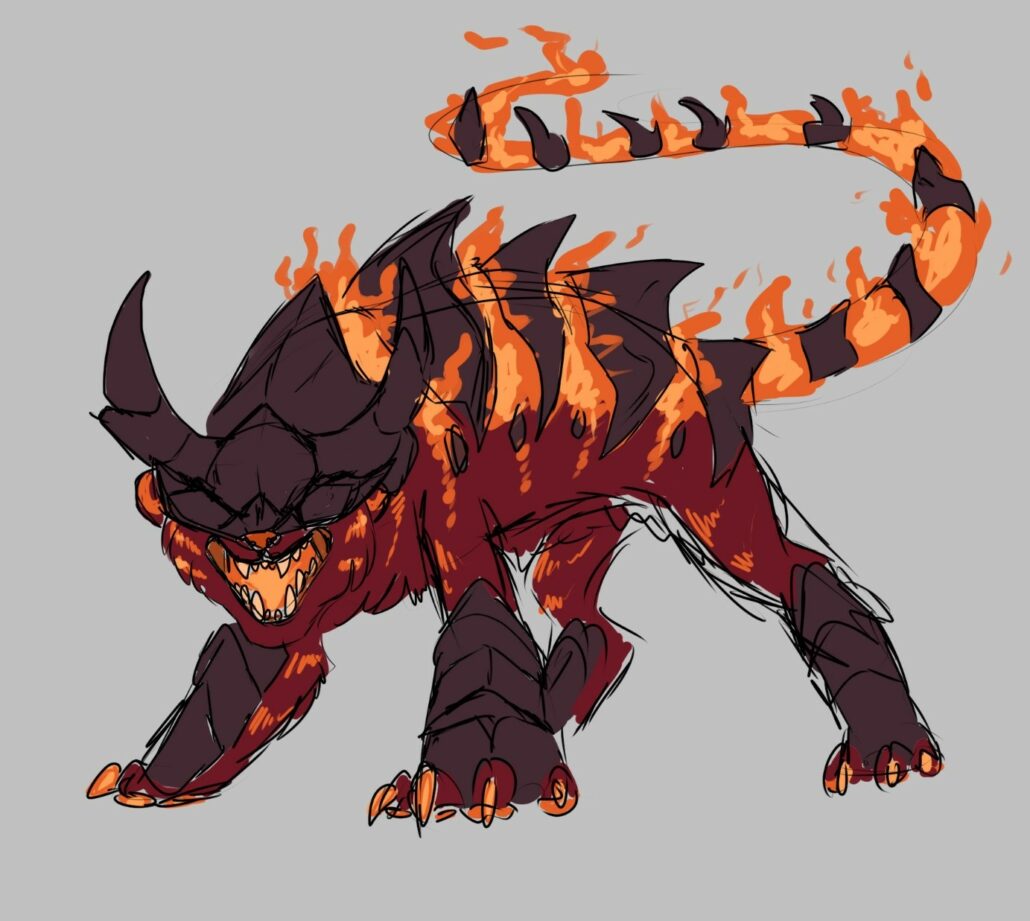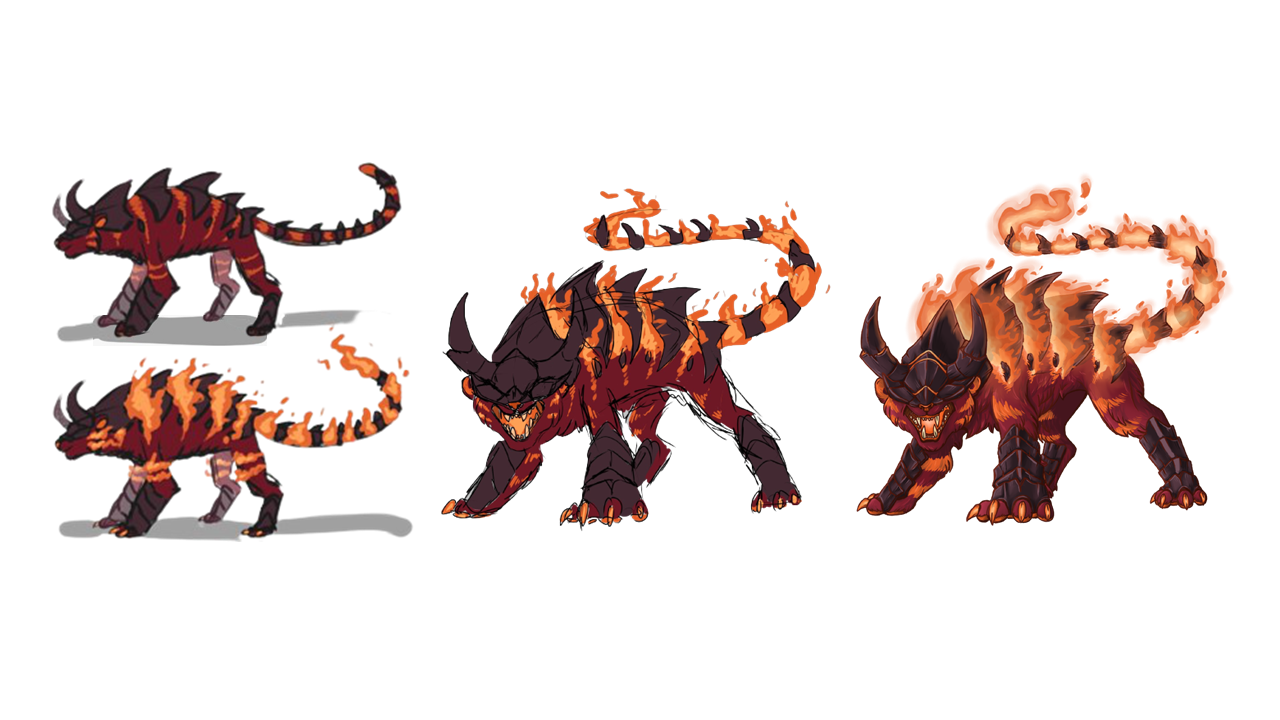Fantastic Beasts and How to Design Them
The graphics and, accordingly, especially the artwork for characters, environments or even monsters are often what make a video game special. As a rule, however, you only get a glimpse behind the scenes of the design process during game development through concept drawings and rarely hear anything from the artists about the "ins and outs". We therefore interviewed our monster artists Somni and Gordon and wanted to know how they actually design monsters. Afterwards, Somni lets you look into her sketchbook and shows you the visual development of a monster using the example of the Brandreißer.
How do you make monsters?
An interview with the "Elements Destiny" monster artists Somni and Gordon
How does one come up with a design idea? What thoughts were given before the design?
Gordon: At the very beginning of the development of the monsters, together with the team, we created a rough list of different animals that we wanted to see as monsters in Elements Destiny, e.g. wolf, wild boar, bat etc.. All animals were then given a matching element from the game, whereby we need roughly the same number of monsters for each area and each element. For the elemental details of the monsters, it was very important to me from the beginning that you can directly see the element at a glance without having to look it up in a monster list. We came up with a few basic design elements for each element (e.g. purple lightning bolts and glass/crystal pieces for thunder) to incorporate into the monster designs. When it came to the basic design of some monsters, however, I personally consciously tried not to take the first thing that came to mind. When you hear the word "golem", for example, the first thing you probably think of is a rocky, clumsy giant. I deliberately wanted to try something different, so I gave it four insect-like legs. Of course, there are also more classical designs, but I rely on my instinct.
Somni: In team calls with Chris and Gordon we talked about possible monster concepts and exchanged ideas. Often, as Gordon says, an element and an animal or creature that fits in with it in terms of feeling come together for the basic idea, e.g. a fire tiger. That is the starting point from which the sketching can begin. Usually I already have a lot of rough design ideas for the general look when I get such a prompt. That's because I've been watching a lot of animal documentaries in general and I like monster movies or games - I just love creature design! In general, I design monsters very freely according to spontaneous ideas that come to me by chance, without any further thought processes. The first, really rough drawings, I even usually do on paper, often doodling several monsters on one sheet and seeing what I and the team like. The next step is to ask myself: "What exactly do I find cool about monsters and how can I implement it with this sketch? And how can I incorporate the typical features of Elements Destiny's fire monsters without it looking gimmicky or weird?". Later, I think about how I can make the silhouette or the overall concept more coherent and how I can improve the monster. To do this, I do a lot of research and compare how other games or films have done it so far. So basically it goes like this: I make a concept, think about lore, let it rest for a while and then maybe revise it again if other ideas come to me. Sometimes I don't even need the process of resting - at that moment I have a clear picture in mind, which remains almost exactly the same until the end.
What does the further path to the final artwork look like?
Somni: In the case of the fire tiger, I had looked for references from real tigers on the internet for my first clean, digital sketch. The version that then emerged had covered everything I could imagine as fitting for this monster and this element with horns, claws, spiky plates and of course fire. During this process, I often automatically have thoughts about the possible lore and way of life of the monster, which could later flow into the journal in the game. I question the anatomical sense of certain parts like plates or spines and what the monster uses them for or how. Based on these considerations, I try to make the final designs as "realistic" and functional as possible. The feedback from the team then helps me. When everything is decided, I start working on the lineart, which is where you see the final version for the first time. If the team likes the lines, I work on the basic colouring and finally the final artwork with shading and all the details is created and ready for use in the game.
Gordon: When I know which animal to base it on, I often look directly at photos or drawings. Using references is totally important to me, so that the basic anatomy of the monsters is hit. Then I bring them together in my head with the basic principles of the game's element designs and start drawing until I have the first sketch. If I'm not happy with the design, then it's rethought and reworked until the new idea feels good. When it comes to the more precise details, it's also important to me that there's something fresh in it, so that the player doesn't immediately think, "Hey, that looks like (...)!". Every design has to feel fresh and new to me. I think that's especially important for my concepts, so that the end result is coherent and exciting.
What were some of the challenges?
Gordon: For me it was a special challenge to draw monsters based on real animals, as I had previously drawn almost only humans. I find it easier to draw insects and reptiles with smooth surfaces, straight edges or scales than animals with lots of fur, for example. Elements Destiny has a lot of monsters, though, so you pretty much draw everything at some point and this routine also brings practice.
Somni: As an artist, I have been drawing more traditionally for a long time and have only recently started using digital tools. When I became the main monster artist, I was particularly concerned about whether I would always get the anatomy of the monsters right in the finished designs. In the meantime, however, I have been able to overcome these uncertainties, as joint review team meetings give me the necessary support and I also learn a lot through experience and the study of anatomy. However, references are and remain the be-all and end-all for me!
Do you have a favourite monster?
Gordon: It's very difficult for me to limit myself to a single favourite monster, because I really like all of them. Maybe it has to do with the fact that a game like Elements Destiny gives you a lot of freedom in the design and I was able to be as creative as I wanted with each monster. That's why I have a special bond with each monster design. My choice would probably be the angler wasp. I think it's kind of cute and it's the first monster I made for ED.
Somni: That's actually a very easy question for me. Although I really like a lot of monsters and I'm very happy right now how much freedom I have in my designs, I can still directly say that the volcano creeper is my favourite monster. I think his design is just great and without giving too much away, I'm also very happy that I got to create my own interpretation of him for the final artwork! Right after that comes Brandreißer for me, as he was the first monster I was allowed to do a final artwork for - so he is my start for many more cool designs.
From Somni's Sketchbook: The Optical Development of the Fire Ripper
Here you can see the lore ideas with the first, quick sketches of the monster.

This then is the more detailed concept for the pose and appearance of the monster in battle.

And this is what the final artwork looks like in the end!

Thanks to Gordon and Somni for your insights!

